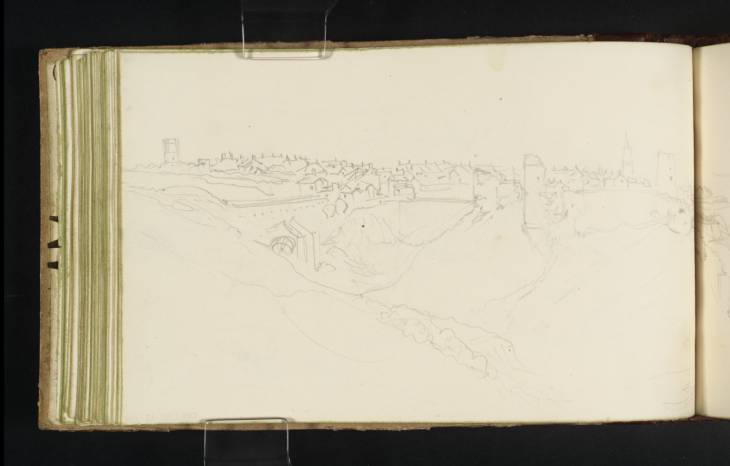J.M.W. Turner
>
1830-35 Annual tourist
>
Scotland 1831
>
Abbotsford Sketchbook
>
Artwork
Joseph Mallord William Turner Berwick-on-Tweed 1831
Image 1 of 2
Joseph Mallord William Turner,
Berwick-on-Tweed
1831
Joseph Mallord William Turner 1775–1851
Folio 48 Verso:
Berwick-on-Tweed 1831
D26009
Turner Bequest CCLXVII 48a
Turner Bequest CCLXVII 48a
Pencil on off-white wove writing paper, 113 x 185 mm
Accepted by the nation as part of the Turner Bequest 1856
References
1909
A.J. Finberg, A Complete Inventory of the Drawings of the Turner Bequest, London 1909, vol.II, p.858, CCLXVII 48a, as ‘Berwick-on-Tweed. See Engraving, Scott’s Poems 1833.’.
1972
Gerald E. Finley, ‘J.M.W. Turner and Sir Walter Scott: Iconography of a Tour’, Journal of the Warburg and Courtauld Institutes, vol.35, 1972, pp.368 note 59, 385 note 149 and 150.
1975
Gerald Wilkinson, Turner’s Colour Sketches 1820–34, London 1975, p.67 reproduced.
1980
Gerald Finley, Landscapes of Memory: Turner as Illustrator to Scott, London 1980, p.131.
1979
Andrew Wilton, J.M.W. Turner: His Life and Work, Fribourg 1979, p.430 under no.1092.
As Finberg and subsequent commentators have noticed,1 the sketch across this page and folio 49 (D26010; CCLXVII 49) formed the basis for Turner’s watercolour, Berwick-upon-Tweed circa 1832 (whereabouts unknown),2 engraved for volume 12 of Sir Walter Scott’s, Poetical Works. Gerald Finley has linked the drawing to entries in Robert Cadell’s diary that records Turner making sketches of Berwick ‘out of Scotsgate in a field on the left hand side on the Dunse Road’ on the 10 and 11 August 1831.3
Cadell only mentioned one sketch which Turner began on the evening of the 10th and completed the next morning. However, Finley points out that a number of studies were made on this occasion (folios 48 verso–49 and 59–60; D26009–D26010, D26026–D26028; 48a–49, 61–62),4 and yet more studies in this and the Berwick sketchbooks can be identified as showing the town: folios 34 – 35, 40 verso, 41, 46 verso, 47, 48 verso, 49, 52 verso and 58 verso in this sketchbook (D25984–D25986, D25995, D25996, D26005, D26006, D26009, D26010, D26016, D26029; CCLXVII 34–35, 40a, 41, 46a, 47, 48a, 49, 52a, 60a); and in the Berwick sketchbook (1831) (see Tate D25665; Turner Bequest CCLXV 13a).
Turner and Cadell parted ways in Berwick on the 11th, with the publisher leaving for Edinburgh shortly after nine o’clock in the morning, and the artist planning to take a coach at two o’clock that afternoon. Turner presumably filled these five hours by making additional studies of the town.
The view of Berwick was intended to illustrate the twelfth volume of Scott’s Poetry, the Dramas, specifically, Halidon Hill. This was an account of a battle in 1333 where the Scots were defeated in their attempt to relieve Berwick from the siege by the English army. The battlefield, Halidon Hill, lies about two miles north-west of Berwick-upon-Tweed, and is little more than a hill and fields. Berwick was therefore chosen as the illustration.
The view is from the north bank of the Tweed to the west of the castle ruins near where the Royal Border Bridge now stands (though it was not yet built). The field that Cadell mentioned is south of Castle Terrace which runs into Duns Road. The ruins include the west curtain wall at the centre right of the present page, perched on the steep cliff above the Tweed, with the ‘white wall’ descending step-like down the cliff to the water at the left of folio 49 (see folio 46 verso; D26005; CCLXVII 46a). At the top left of folio 48 verso is another part of the town’s medieval defensive structure, the sixteenth-century Bell Tower, defending the line of the medieval town wall (see D25693; Turner Bequest CCLXV 29). Berwick itself appeared as a jumble of houses and roofs, with the mid-eighteenth-century Town Hall spire rising above the town and castle. The view continues on folio 49 looking east along the River Tweed with Berwick Bridge and Tweedmouth to the south of the river.
Thomas Ardill
September 2009
How to cite
Thomas Ardill, ‘Berwick-on-Tweed 1831 by Joseph Mallord William Turner’, catalogue entry, September 2009, in David Blayney Brown (ed.), J.M.W. Turner: Sketchbooks, Drawings and Watercolours, Tate Research Publication, December 2012, https://www


